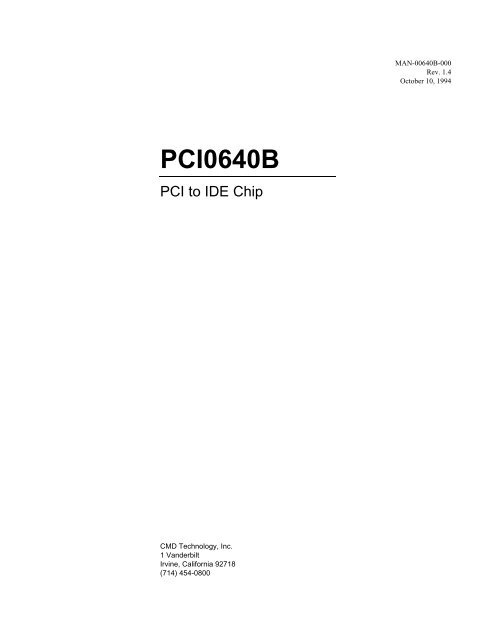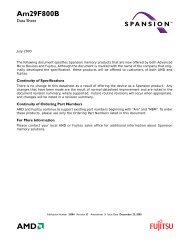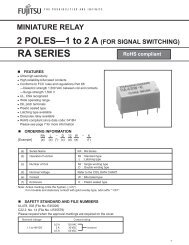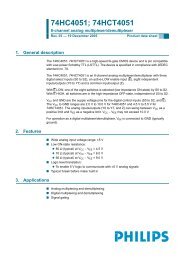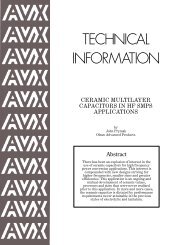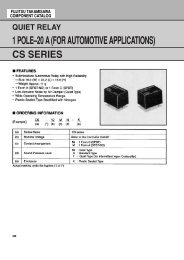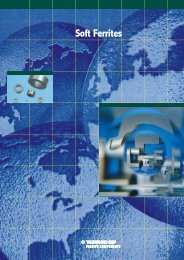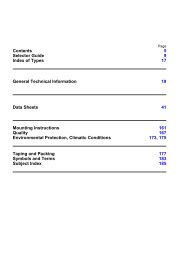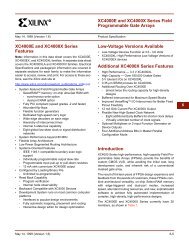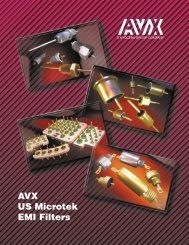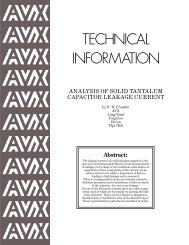PCI0640B - FTP Directory Listing
PCI0640B - FTP Directory Listing
PCI0640B - FTP Directory Listing
Create successful ePaper yourself
Turn your PDF publications into a flip-book with our unique Google optimized e-Paper software.
MAN-00640B-000<br />
Rev. 1.4<br />
October 10, 1994<br />
<strong>PCI0640B</strong><br />
PCI to IDE Chip<br />
CMD Technology, Inc.<br />
1 Vanderbilt<br />
Irvine, California 92718<br />
(714) 454-0800
This page left blank intentionally.<br />
2
Table of Contents<br />
1 Interface Specifications 1-1<br />
1.1 PCI Mode Pin Descriptions ..........................................................................................1-1<br />
1.2 VL Mode Pin Descriptions............................................................................................1-6<br />
1.3 I/O Registers................................................................................................................1-10<br />
1.3.1 Configuration Registers........................................................................................1-10<br />
1.3.2 Common Registers ..............................................................................................1-12<br />
1.3.3 Active Count Function..........................................................................................1-15<br />
1.3.4 Recovery Count Function.....................................................................................1-15<br />
1.3.5 Task File Registers ..............................................................................................1-16<br />
1.4 Configuration Setup ...................................................................................................1-16<br />
1.4.1 VL Mode...............................................................................................................1-16<br />
1.4.2 PCI Mode Configuration.......................................................................................1-16<br />
1.4.3 Configuration Mechanism #2 ...............................................................................1-16<br />
1.4.4 VL-Mode Operation..............................................................................................1-17<br />
1.5 <strong>PCI0640B</strong> Interrupt Processing on PCI.....................................................................1-17<br />
1.6 Read Ahead Operation ...............................................................................................1-17<br />
1.7 <strong>PCI0640B</strong> IDE Controller Pinout ................................................................................1-17<br />
1.7.1 Host Interface Pinout............................................................................................1-17<br />
1.7.2 Drive Interface Pinout...........................................................................................1-19<br />
1.7.3 VDD/VSS Pins .....................................................................................................1-20<br />
1.8 Jumper Settings..........................................................................................................1-20<br />
2 Power Specifications 2-1<br />
2.1 DC Specifications .........................................................................................................2-1<br />
2.1.1 Maximum Ratings ..................................................................................................2-1<br />
2.1.2 Recommended Operating Conditions ....................................................................2-1<br />
2.2 DC Characteristics........................................................................................................2-1<br />
Table of Contents<br />
0-iii
<strong>PCI0640B</strong><br />
2.3 AC Specifications .........................................................................................................2-2<br />
2.3.1 Timing Waveform ...................................................................................................2-2<br />
2.3.2 Clock Timing ..........................................................................................................2-2<br />
2.3.3 Host Interface Timing (loading = 50 pf)..................................................................2-2<br />
2.3.4 IDE Drive Timing (loading = 75 pf).........................................................................2-3<br />
2.3.5 IDE Drive Timing (loading = 120 pf).......................................................................2-3<br />
2.4 Output Test Load ..........................................................................................................2-3<br />
2.5 IDE Write Timing ...........................................................................................................2-4<br />
2.6 Host Read/Write Timing ...............................................................................................2-4<br />
2.7 VCLK, RESET# Timing .................................................................................................2-5<br />
2.8 PCI Host Timing ............................................................................................................2-6<br />
2.9 VL Mode Timing ............................................................................................................2-7<br />
2.10 IDE Timing ...................................................................................................................2-8<br />
A Diagrams A-1<br />
0-iv<br />
Table of Contents
1 Interface Specifications<br />
1.1 PCI Mode Pin Descriptions<br />
The following is an alphabetical listing of PCI mode signals and their pin assignments. Please refer to the<br />
PCI mode pinout diagram for the locations of the pins.<br />
Signal Pin I/O<br />
AD[31..0] 7-14, 17-20, 23-26, 28-35, 42-49 IO<br />
Function<br />
Address and Data are multiplexed on the same PCI pins. A bus transaction consists of an address phase<br />
followed by one or more data phases. PCI supports both read and write bursts. The address phase is the clock<br />
cycle in which FRAME # is asserted. During the address phase AD[31..0] contain a physical address (32 bits).<br />
For I/O, this is a byte address; for configuration and memory it is a DWORD address. During data phases<br />
AD[7..0] contain the least significant byte (lsb) and AD[31..24] contain the most significant byte (msb). Write<br />
data are stable and valid when IRDY# is asserted and read data are stable and valid when TRDY# is asserted.<br />
Data are transferred during those clocks where both IRDY# and TRDY# are asserted.<br />
Signal Pin I/O<br />
C/BE[3..0]# 3-6 I<br />
Function<br />
Byte Enable bits 0 through 3 form the host CPU address bus. These inputs are active low and specify which<br />
bytes will be valid for host read/write data transfers.<br />
Signal Pin I/O<br />
DCS0# 55 IO<br />
Function<br />
Disk Chip Select 0 is normally active low output and is used to select the first IDE port command block<br />
registers in the drive(s). This signal connects directly to the ATA bus connector. DCS0# is used as an input at<br />
reset to specify <strong>PCI0640B</strong> operating modes (see Jumper Settings on page 1-20). DCS0# is sampled as an<br />
input on the rising edge of RESET#. This pin is internally pulled up.<br />
Signal Pin I/O<br />
DCS1# 56 IO<br />
Function<br />
Disk Chip Select 1 is normally active low output which is used to select the first IDE port auxiliary registers in<br />
the drive(s). This signal connects directly to the ATA bus connector. DCS1# is used as an input at reset to<br />
specify <strong>PCI0640B</strong> operating modes (see Jumper Settings on page 1-20). DCS1# is sampled as an input on the<br />
rising edge of RESET#. This pin is internally pulled up.<br />
Interface Specifications 1-1
<strong>PCI0640B</strong><br />
Signal Pin I/O<br />
DCS2# 80 O<br />
Function<br />
Disk Chip Select 2. Used to select second IDE port command registers in the drive.<br />
Signal Pin I/O<br />
DCS3# 79 O<br />
Function<br />
Disk Chip Select 3. Used to select second IDE port auxiliary register.<br />
Signal Pin I/O<br />
DEVSEL# 93 O<br />
Function<br />
Device Select, when actively driven, indicates the driving device has decoded its address as the target of the<br />
current access. As an input, it indicates to a master whether any device on the bus has been selected.<br />
Signal Pin I/O<br />
DIO16# 61 I<br />
Function<br />
Disk I/O 16 is an active low input which indicates that the disk drive is ready to perform a 16-bit data transfer.<br />
The signal connects directly to the ATA connector and will typically be driven active by the drive during<br />
<strong>PCI0640B</strong> transfers to the drive's 1F0h data port. Note that an external 1K-ohm pull-up resistor and a 47pF<br />
capacitor pull-down is recommended for this signal.<br />
Signal Pin I/O<br />
DIOR# 57 (primary port), 77 (secondary port) O<br />
Function<br />
Disk IO Read is an active low output which enables data to be read from the drive. The duration and repetition<br />
rate of DIOR# cycles is determined by <strong>PCI0640B</strong> programming. DIOR# is driven high when inactive.<br />
Signal Pin I/O<br />
DIOW# 58 (primary port), 78 (secondary port) O<br />
Function<br />
Disk I/O Write is an active low output that enables data to be written to the drive. The duration and repetition<br />
rate of DIOW# cycles is determined by <strong>PCI0640B</strong> programming. DIOW# is driven high when inactive.<br />
Signal Pin I/O<br />
DIRQ1 75 I<br />
Function<br />
Disk Interrupt is an input to the <strong>PCI0640B</strong> used to generate the IRQ14 output. DIRQ1 is asserted low then high<br />
by the drive at the beginning of a block transfer. This input should have a 4.7K-ohm pull-up and a 470pF<br />
capacitor pull-down connected to it.<br />
1-2 Interface Specifications
<strong>PCI0640B</strong><br />
Signal Pin I/O<br />
DIRQ2 86 I<br />
Function<br />
Disk interrupt input for secondary IDE port is used to generate the IRQ15 output. DIRQ2 is asserted low then<br />
high by the drive at the beginning of a block transfer. This input should have a 4.7K-ohm pull-up and a 470pF<br />
capacitor pull-down.<br />
Signal Pin I/O<br />
DRST# 59 O<br />
Function<br />
Disk ReSeT is an active low output which signals the IDE drive(s) to initialize its control registers. DRST# is a<br />
buffered version of the RESET# input and connects directly to the ATA connector.<br />
Signal Pin I/O<br />
DSA[2..0] 70, 69, 68 IO<br />
Function<br />
Disk Address bits 0 through 2 are normally outputs to the ATA connector for register selection in the drive(s).<br />
These signals are decoded from the A2 and C/BE[3..0] inputs. DSA[2..0] are also sampled as inputs on the<br />
falling edge of RESET#. All of these pins have internal pull-up resistors. 2.2k resistors are recommended<br />
where pull-downs are required. (See “Jumper Settings” on page 1-20.)<br />
Signal Pin I/O<br />
DSD[15..0] 36-39, 50-53, 62-65, 71-74 IO<br />
Function<br />
Disk Data bits 0 through 15 are the 16-bit bi-directional data bus which connects to the IDE drive(s). DSD[7..0]<br />
define the lowest data byte while DSD[15..8] define the most significant data byte. The DSD bus is normally in<br />
a high-impedance state and is driven by the <strong>PCI0640B</strong> only during the DIOW# command pulse.<br />
Signal Pin I/O<br />
ENDSKCHG# 85 I<br />
Function<br />
ENDSKCHG# enables or disables reads to port 3F7. Use 2.2K-ohm pull-down resistors to enable. Port 3F7 is<br />
disabled by default.<br />
Signal Pin I/O<br />
ENIDE 21 I<br />
Function<br />
ENable IDE is an active high input that controls the <strong>PCI0640B</strong>'s default disk operation mode following reset.<br />
When set low, the <strong>PCI0640B</strong>'s IDE cycles are disabled following reset. This mode allows software to scan for<br />
system hardware and enable the <strong>PCI0640B</strong> via the PCMD register (index 4). When left floating or pulled high,<br />
the <strong>PCI0640B</strong> is enabled and cannot be disabled via software.<br />
Interface Specifications 1-3
<strong>PCI0640B</strong><br />
Signal Pin I/O<br />
FRAME # 98 I<br />
Function<br />
Cycle Frame is driven by the current master to indicate the beginning and duration of an access. FRAME # is<br />
asserted to indicate a bus transaction is beginning. While FRAME # is asserted, data transfers continue. When<br />
FRAME # is deasserted, the transaction is in the final data phase.<br />
Signal Pin I/O<br />
IDSEL# 100 I<br />
Function<br />
Initialization Device Select is used as a chip select during configuration read and write transactions.<br />
Signal Pin I/O<br />
INTA# 84 O/D<br />
Function<br />
Interrupt A is used to request an interrupt in PCI IDE Native Mode. INTA# is tri-stated when both IDE ports are<br />
in Legacy Mode.<br />
Signal Pin I/O<br />
IOCHRDY 76 I<br />
Function<br />
I/O Channel Ready is an active high input that indicates that the IDE disk drive has completed the current<br />
command cycle. A 1K-ohm pull-up resistor is recommended.<br />
Signal Pin I/O<br />
IRDY# 99 I<br />
Function<br />
Initiator Ready indicates the initializing agent's (bus master's) ability to complete the current data phase of the<br />
transaction. This signal is used with TRDY#. A data phase is completed on any clock when both IRDY# and<br />
TRDY# are sampled asserted. Wait cycles are inserted until both IRDY# and TRDY# are asserted together.<br />
Signal Pin I/O<br />
IRQ14 22 O<br />
Function<br />
IRQ14 is used to request an interrupt in PCI IDE Legacy Mode. (For PC-AT compatibles.) IRQ14 is tri-stated<br />
when IDE port 0 is in Native Mode.<br />
Signal Pin I/O<br />
IRQ15 83 O<br />
Function<br />
IRQ15 is used to request an interrupt for secondary IDE port in PCI IDE Legacy Mode. (PC-AT compatible.)<br />
IRQ15 is tri-stated when IDE port 1 is in Native Mode.<br />
1-4 Interface Specifications
<strong>PCI0640B</strong><br />
Signal Pin I/O<br />
PAR 96 I<br />
Function<br />
PAR is even parity across AD[31..0] and C/BE[3..0]#. Parity generation is required by all PCI agents. PAR is<br />
stable and valid one clock after the address phase. For data phases PAR is stable and valid one clock after<br />
either IRDY# is asserted on a write transaction or TRDY# is asserted on a read transaction. Once PAR is valid,<br />
it remains valid until one clock after the completion of the current data phase. (PAR has the same timing as<br />
AD[31..0] but delayed by one clock.)<br />
Signal Pin I/O<br />
PCICLK 89 I<br />
Function<br />
Clock Signal provides timing for all transactions on PCI and is an input to every PCI device. All other PCI<br />
signals, except RESET# and IRQ, are sampled on the rising edge of PCICLK, and all other timing parameters<br />
are defined with respect to this edge.<br />
Signal Pin I/O<br />
PCIMODE 2 I<br />
Function<br />
PCIMODE is set to high when chip is used in PCI bus. When chip is used in VL bus, PCIMODE is set to low.<br />
Signal Pin I/O<br />
PERR# 95 IO<br />
Function<br />
Error may be pulsed active by an agent that detects a parity error. PERR# can be used by any agent to signal<br />
data corruptions. However, on detection of a PERR# pulse, the central resource may generate a nonmaskable<br />
interrupt to the host CPU, which often implies that the system will be unable to continue operation once error<br />
processing is complete.<br />
Signal Pin I/O<br />
RESET# 1 I<br />
Function<br />
RESET# is an active low input that is used to set the internal registers of the <strong>PCI0640B</strong> to their initial state.<br />
RESET# is typically the system power-on reset signal as distributed on the PCI bus.<br />
Signal Pin I/O<br />
STOP# 97 IO<br />
Function<br />
STOP# indicates the current target is requesting the master to stop the current transaction.<br />
Interface Specifications 1-5
<strong>PCI0640B</strong><br />
Signal Pin I/O<br />
TRDY# 92 O<br />
Function<br />
Target Ready indicates the target agent's ability to complete the current data phase of the transaction. TRDY#<br />
is used with IRDY#. A data phase is completed on any clock when both TRDY# and IRDY# are sampled<br />
asserted. During a read, TRDY# indicates that valid data is present on AD(31..0). During a write, it indicates<br />
the target is prepared to accept data.<br />
Signal Pin I/O<br />
VDD 16, 41, 67, 91 I<br />
Function<br />
Positive power supply input.<br />
Signal Pin I/O<br />
VSS 15, 27, 40, 54, 66, 90 I<br />
Function<br />
Ground reference power supply input.<br />
1.2 VL Mode Pin Descriptions<br />
The following is an alphabetical listing of VL mode signals and their pin assignments. Please refer to the VL<br />
mode pinout diagram for the locations of the pins.<br />
Signal Pin I/O<br />
ADS# 98 I<br />
Function<br />
ADdress Strobe is an active low input that indicates that there is a valid address and command on the bus.<br />
ADS# connects directly to the host CPU ADS# signal.<br />
Signal Pin I/O<br />
BE[3..0] 3-6 I<br />
Function<br />
Byte Enable bits 0 through 3 (together with the HA[15..2] signals) form the host CPU address bus. These<br />
inputs are active low and specify which bytes will be valid for host read/write data transfers.<br />
Signal Pin I/O<br />
CS0# 55 IO<br />
Function<br />
Chip Select 0 is normally an active low output that is used to select the command block regiisters in the<br />
drive(s). This signal connects directly to the ATA bus connector. DCS0# is used as an input at reset to specify<br />
<strong>PCI0640B</strong> operating modes. DCS0# is sampled as an input on the falling edge of RESET#.<br />
1-6 Interface Specifications
<strong>PCI0640B</strong><br />
Signal Pin I/O<br />
CS1# 56 IO<br />
Function<br />
Chip Select 1 is normally an active low output that is used to select the control block registers in the drive(s).<br />
This signal connects directly to the ATA bus connector. As an input DCS1# is used to specify <strong>PCI0640B</strong><br />
operating modes. DCS1# is sampled as an input on the falling edge of RESET#.<br />
Signal Pin I/O<br />
DC# 96 I<br />
Function<br />
Data or Control is a low input that is used to distinguish between I/O and interrupt or halt cycles.<br />
Signal Pin I/O<br />
DCHRDY 76 I<br />
Function<br />
Disk ReaDY is an active high input that indicates that the IDE disk drive has completed the current command<br />
cycle. DCHRDY is sampled at the rising edge of VLCLK at the programmed end of the command cycle. If<br />
DCHRDY is high, the command is terminated. If DCHRDY is sampled low, the command cycle is extended.<br />
DCHRDY will then be sampled with every positive VLCLK edge until it is tested high. Once sampled high, the<br />
command will end normally. Note that an external 1K-ohm pull-up resistor should be connected to this pin for<br />
normal operation.<br />
Signal Pin I/O<br />
DIO16# 61 I<br />
Function<br />
Disk I/O 16 is an active low input that indicates that the disk drive is ready to perform a 16-bit data transfer.<br />
The signal connects directly to the ATA connector and will typically be driven active by the drive during<br />
<strong>PCI0640B</strong> transfers to the drive's 1F0h data port. Note that an external 1K-ohm pull-up resistor and a 47pF<br />
pull-down capacitor are recommended for this signal.<br />
Signal Pin I/O<br />
DIOR# 57 O<br />
Function<br />
Disk I/O Read is an active low output that enables data to be read from the drive. The duration and repetition<br />
rate of DIOR# cycles is determined by <strong>PCI0640B</strong> programming. DIOR# is driven high when inactive.<br />
Signal Pin I/O<br />
DIOW# 58 O<br />
Function<br />
Disk I/O Write is an active low output that enables data to be written to the drive. The duration and repetition<br />
rate of DIOW# cycles is determined by <strong>PCI0640B</strong> programming. DIOW# is driven high when inactive.<br />
Interface Specifications 1-7
<strong>PCI0640B</strong><br />
Signal Pin I/O<br />
DIRQ 75 I<br />
Function<br />
Disk Interrupt is an input to the <strong>PCI0640B</strong> used to generate the IRQ14 output. DIRQ is asserted low then high<br />
by the drive at the beginning of a data block transfer. This input should have a 4.7K-ohm pull-up connected to<br />
it.<br />
Signal Pin I/O<br />
DRST# 59 O<br />
Function<br />
Disk ReSeT is an active low output that signals the IDE drive(s) to initialize its control registers. DRST# is an<br />
inverted, buffered version of the RESET input and connects directly to the ATA connector.<br />
Signal Pin I/O<br />
DSA[2..0] 70, 69, 68 IO<br />
Function<br />
Disk Address, bits 0 through 2, are normally outputs to the ATA connector for register selection in the drive(s).<br />
These signals are decoded from the A2 and BE[3..0] inputs. DSA[2..0] are also sampled as inputs at reset to<br />
specify the least significant bits of the device ID number. These signals are recommended to have 10K-ohm<br />
pull-up or pull-down resistors. DSA[2..0] are sampled as inputs on the rising edge of RESET#.<br />
Signal Pin I/O<br />
DSD[15..0] 36-74 IO<br />
Function<br />
Disk Data, bits 0 through 15, are the 16-bit bi-directional data bus that connects to the IDE drive(s). DSD[7..0]<br />
define the lowest data byte while DSD[15..8] define the most significant data byte. The DSD bus is normally in<br />
a high-impedance state and is driven by the <strong>PCI0640B</strong> only during the DIOW# command pulse.<br />
Signal Pin I/O<br />
ENIDE 21 I<br />
Function<br />
In VL mode, ENable IDE enables the <strong>PCI0640B</strong> chip when set HIGH and disables the chip when set LOW.<br />
Signal Pin I/O<br />
HA[15..2] 77-98 I<br />
Function<br />
Host Address bits 2 thorugh 15 (together with the BE[3..0]# signals) form the host CPU address bus.<br />
Signal Pin I/O<br />
HD[31..0] 7-20, 23-26, 28-35, 42-49 IO<br />
Function<br />
Host Data is the 32-bit bi-directional data bus that connects to the host CPU. HD[7..0] define the lowest data<br />
byte, while HD[31..24] define the most significant data byte. The active byte(s) on a CPU transfer are specified<br />
by the BE[3..0]# signals. The HD bus is normally in a high-impedance stat and is driven only during T2 states<br />
of <strong>PCI0640B</strong> read cycles.<br />
1-8 Interface Specifications
<strong>PCI0640B</strong><br />
Signal Pin I/O<br />
IRQ 22 O<br />
Function<br />
Interrupt ReQest is an tri-state output normally connected to IRQ14 of the ISA bus. When <strong>PCI0640B</strong> is<br />
enabled, the IRQ14 output will track the DIRQ input. Otherwise IRQ is in a high-impedance state.<br />
Signal Pin I/O<br />
LDEV# 93 O<br />
Function<br />
Local DEVice is an active low output that indicates that the current host CPU address is a valid <strong>PCI0640B</strong><br />
address. LDEV# is normally in a high-impedance state and is asynchronously decoded from the HA[15..2],<br />
MIO# and DC# signals. LDEV# typically connects to the system “chipset” logic. Note that LDEV# may glitch<br />
during address transitions and should be sampled appropriately by the chipset.<br />
Signal Pin I/O<br />
LRDY0# 92 O<br />
Function<br />
Local ReaDY 0 is an active low output that indicates that the current host CPU transfer is complete. LRDY# is<br />
typically connected to either the CPU directly or the PC system “chipset” as determined by the operation of the<br />
chipset. LRDY0# is normally in a high-impedance state and functions in an “open collector” style. As a<br />
<strong>PCI0640B</strong> cycle is completed, LRDY0# will first be enabled driving high and then immediately pulled low. It will<br />
remain active for 1 t-state, then drive high and finally be disabled to end the sequence.<br />
Signal Pin I/O<br />
MIO# 97 I<br />
Function<br />
Memory or I/O is an input that distinguishes between memory and I/O cycles.<br />
Signal Pin I/O<br />
PCIMODE 2 I<br />
Function<br />
PCIMODE distinguishes between PCI mode and VL mode: HIGH for PCI mode and LOW for VL mode.<br />
Signal Pin I/O<br />
RDY# 99 I<br />
Function<br />
CPU ReaDY is an active low signal that indicates the end of the current host CPU transfer. RDY# connects<br />
directly to the host CPU's READY# input. The <strong>PCI0640B</strong> tracks this signal to ensure that it remains in<br />
synchronization with the CPU under all conditions.<br />
Signal Pin I/O<br />
RESET# 1 I<br />
Function<br />
CPU ReSeT is an active low input.<br />
Interface Specifications 1-9
<strong>PCI0640B</strong><br />
Signal Pin I/O<br />
VDD 16, 41, 67, 91 I<br />
Function<br />
Positive power supply input.<br />
Signal Pin I/O<br />
VLCLK 89 I<br />
Function<br />
CLocK is the host CPU clock signal. It connects directly to the VL bus clock input.<br />
Signal Pin I/O<br />
VSS 15, 27, 40, 54, 66, 90 I<br />
Function<br />
Ground reference power supply input.<br />
Signal Pin I/O<br />
WR# 100 I<br />
Function<br />
Write or Read is an input that is used to distinguish between write and read cycles.<br />
Signal Pin I/O<br />
Function<br />
Not used.<br />
60<br />
1.3 I/O Registers<br />
1.3.1 Configuration Registers<br />
Name Function Index<br />
VID Vendor ID (1095h) (RO) 0-1<br />
Name Function Index<br />
DID Device ID (0640h) (RO) 2-3<br />
1-10 Interface Specifications
<strong>PCI0640B</strong><br />
Name Function Index<br />
PCMD Command Register (RW) 4-5<br />
Bits<br />
15-9 reserved<br />
8-7 always 0<br />
6 0 disable parity error response<br />
1 enable parity error response<br />
5-1 always 0<br />
0 1 IDE enabled<br />
0 IDE disabled<br />
Name Function Index<br />
PSTTS Status Register (RW) 6-7<br />
Bits<br />
15 detected parity error<br />
14 always 0<br />
13 always 0<br />
12 always 0<br />
11 always 0<br />
10-9 DEVSEL timing (RO)<br />
00 fast<br />
01 medium<br />
10 slow<br />
8-0 reserved<br />
Name Function Index<br />
REVID Revision ID (RO) 8<br />
Name Function Index<br />
PROGIF<br />
Programming interface = 00h (RO) when DSA1 is pulled down at reset<br />
= 0Ah (RW) when DSA1 is not pulled down at reset.<br />
Bits 0-3 are used to toggle between Legacy and Native Modes.<br />
9<br />
Name Function Index<br />
SUBCL Sub-class = 01h IDE controller (RO) Ah<br />
Name Function Index<br />
BASCL Base class = 01h Mass storage controller (RO) Bh<br />
Name Function Index<br />
BaseA0 Base address register 0 (R/W) 10-13h<br />
Name Function Index<br />
BaseA1 Base address register 1 (R/W) 14-17h<br />
Interface Specifications 1-11
<strong>PCI0640B</strong><br />
Name Function Index<br />
BaseA2 Base address register 2 (R/W) 18-1Bh<br />
Name Function Index<br />
BaseA3 Base address register 3 (R/W) 1C-1Fh<br />
Name Function Index<br />
INTLINE Interrupt Line (R/W) = 14 (0Eh) 3Ch<br />
Name Function Index<br />
INPINE Interrupt Pin (RO) = 1 3Dh<br />
1.3.2 Common Registers<br />
Name Function Index<br />
CFR Configuration (RO) 50h<br />
Bits<br />
7 DSA0 Jumper<br />
0—Disable ID write<br />
1—Enable ID write<br />
6 DSA1 Jumper<br />
0—Disable Base address register; R=0<br />
1—Enable Base address register R/W<br />
5 VESA configuration port selection<br />
0—178h, 17Ch<br />
1—078h, 07Ch<br />
4-3 Device ID selection<br />
00—60h<br />
01—61h<br />
10—62h<br />
11—63h<br />
2 IDE drive 0/1 interrupt status<br />
Read CFR will clear this bit<br />
0—no interrupt pending<br />
1—interrupt pending<br />
1-0 Device revision = 02<br />
1-12 Interface Specifications
<strong>PCI0640B</strong><br />
Name Function Index<br />
CNTRL Control Register (RW) 51h<br />
Bits<br />
7 Drive 1 read ahead<br />
0—enable<br />
1—disable (default)<br />
6 Drive 0 read ahead<br />
0—enable<br />
1—disable<br />
5 Host write FIFO/reg longer data hold time<br />
0—enable (FIFO data valid until rising edge of TRDY#)<br />
1—disable (FIFO data valid until falling edge of TRDY#)<br />
4 PCI parity check<br />
0—enable<br />
1—disable<br />
3 2nd port<br />
0—disable (default)<br />
1—enable<br />
2 Devsel timing<br />
0—medium<br />
1—fast<br />
1 Host write timing to FIFO<br />
0—slow timing (5 clocks if Bit 5 = 0; 4 clocks if Bit 5 = 1)<br />
1—fast timing (4 clocks if Bit 5 = 0; 3 clocks if Bit 5 = 1)<br />
0 Host read timing from FIFO<br />
0—slow timing (5 clocks)<br />
1—fast timing (3 clocks)<br />
Name Function Index<br />
CMDTIM IDE Command Block Timing Register (RW) 52h<br />
Bits<br />
7-4 IOR/W active count<br />
3-0 Command Recovery count<br />
Name Function Index<br />
ARTTIM0 Drive 0 Address Setup Register (RW) 53h<br />
Bits<br />
7-6 Address setup count<br />
00—4 clks<br />
01—2 clks<br />
10—3 clks<br />
11—5 clks<br />
5-0 reserved<br />
Name Function Index<br />
DRWTIM0 Drive 0 Data Read/Write Timing Register (RW) 54h<br />
Bits<br />
7-4 active count<br />
3-0 recovery count<br />
Interface Specifications 1-13
<strong>PCI0640B</strong><br />
Name Function Index<br />
ARTTIM1 Drive 1 Address Setup Register (RW) 55h<br />
Bits<br />
7-6 Address setup count<br />
00—4 clks<br />
01—2 clks<br />
10—3 clks<br />
11—5 clks<br />
Bit 5-0<br />
reserved<br />
Name Function Index<br />
DRWTIM1 Drive 1 Data Read/Write Timing Register (RW) 56h<br />
Bits<br />
7-4 active count<br />
3-0 recovery count<br />
Name Function Index<br />
ARTTIM23 Drive 2/3 Address Setup Register (RW) 57h<br />
Bits<br />
7-6 Address setup count<br />
00—4 clks<br />
01—2 clks<br />
10—3 clks<br />
11—5 clks<br />
5 reserved<br />
4 IDE drive 2/3 interrupt status<br />
Read ARTTIM23 will clear this bit<br />
0—no interrupt pending<br />
1—interrupt pending<br />
3 Drive 3 read ahead<br />
0—enable<br />
1—disable (default)<br />
2 Drive 2 read ahead<br />
0—enable<br />
1—disable (default)<br />
Name Function Index<br />
DRWTIM23 Drive 2/3 Data Read/Write Timing Register (RW) 58h<br />
Bits<br />
7-4 active count<br />
3-0 recovery count<br />
Name Function Index<br />
BRST<br />
Burst Length Control Register (RW)<br />
default = 40h<br />
This value equals the read-ahead count in quad words.<br />
Example: 40h x 8 = 200h (512) bytes<br />
59h<br />
1-14 Interface Specifications
<strong>PCI0640B</strong><br />
1.3.3 Active Count Function<br />
Active Count<br />
R/W Active Time<br />
0000 16 clks<br />
0001 2 clks<br />
0010 2 clks<br />
0011 3 clks<br />
0100 4 clks<br />
0101 5 clks<br />
0110 6 clks<br />
0111 7 clks<br />
1000 8 clks<br />
1001 9 clks<br />
1010 10 clks<br />
1011 11 clks<br />
1100 12 clks<br />
1101 13 clks<br />
1110 14 clks<br />
1111 15 clks<br />
1.3.4 Recovery Count Function<br />
Recovery Count<br />
Active count<br />
0 or 4 to15<br />
Read Recovery Time<br />
Active count<br />
1 to 3<br />
Write Recovery Time<br />
0000 17 clks 17 clks 17 clks<br />
0001 3 clks 2 clks 3 clks<br />
0010 3 clks 3 clks 3 clks<br />
0011 4 clks 4 clks 4 clks<br />
0100 5 clks 5 clks 5 clks<br />
0101 6 clks 6 clks 6 clks<br />
0110 7 clks 7 clks 7 clks<br />
0111 8 clks 8 clks 8 clks<br />
1000 9 clks 9 clks 9 clks<br />
1001 10 clks 10 clks 10 clks<br />
1010 11 clks 11 clks 11 clks<br />
1011 12 clks 12 clks 12 clks<br />
1100 13 clks 13 clks 13 clks<br />
1101 14 clks 14 clks 14 clks<br />
1110 15 clks 15 clks 15 clks<br />
1111 16 clks 16 clks 16 clks<br />
Interface Specifications 1-15
<strong>PCI0640B</strong><br />
1.3.5 Task File Registers<br />
Name Host Addr Function<br />
HDATA* 1F0(170) data register (RW)<br />
HDWPC 1F1(171) write pre-comp (WO)<br />
HDERR 1F1(171) error register (RO)<br />
HDSCT 1F2(172) sector count (RW)<br />
HDSSN 1F3(173) starting sector # (RW)<br />
HDCLL 1F4(174) cylinder low (RW)<br />
HDCLH 1F5(175) cylinder high (RW)<br />
HDSDH 1F6(176) SDH (RW)<br />
HDCMD 1F7(177) command (WO)<br />
HDSTT 1F7(177) status (RO)<br />
HDFDR 3F6(376) fixed disk control auxiliary register (WO)<br />
HDASR 3F6(376) alternate status auxiliary register (RO)<br />
*HDATA can be accessed as a 16-bit-wide register, for all commands. HDATA can be accessed as a 32-bitwide<br />
register for read/read multiple/write/write multiple commands when read ahead is enabled.<br />
1.4 Configuration Setup<br />
1.4.1 VL Mode<br />
1) Write to port 78h (178h) with 5xh to set the register index.<br />
2) Read/write port 7Ch (17Ch) to access the selected register.<br />
1.4.2 PCI Mode Configuration<br />
Depending on your motherboard chip set, either Configuration Mechanism #1 or Configuration Mechanism<br />
#2 is applicable. Configuration Mechanism #2 is described below. For Configuration #1 methodology, refer<br />
to the PCI Spec 2.0.<br />
Notes:<br />
1) Although PCI BIOS (INT 1Ah) is a portable alternative to Mechanism #1 and #2, it is not<br />
recommended because MS-DOS's EMM386.SYS causes the system to hang when function Find PCI<br />
Device is accessed (AMI and Phoenix BIOS).<br />
2) The PCI-0640B supports byte/word/dword reads, but supports only byte/word writes to the<br />
configuration registers.<br />
1.4.3 Configuration Mechanism #2<br />
1) Enter PCI Configuration Mode by writing 10h to port CF8h.<br />
2) Scan the PCI device IDs from 0h to Fh for the presence of a PCI-0640B controller. (There should be<br />
1095h in port Cx00h and 0640h in port Cx02h, where x=device ID.)<br />
3) To read or write internal registers, read or write to port Cxyyh, where x=device ID from (2) and<br />
yy=configuration register's index.<br />
4) Exit PCI Configuration Mode by writing 00 to port CF8h.<br />
1-16 Interface Specifications
<strong>PCI0640B</strong><br />
1.4.4 VL-Mode Operation<br />
1) If multiple <strong>PCI0640B</strong> devices are present, the host CPU selects a <strong>PCI0640B</strong> device for an I/O IDE<br />
operation by writing device ID (60h to 63h) to 078h (or 178h). This step is skipped if only one<br />
<strong>PCI0640B</strong> is present in the system.<br />
2) Normal I/O requests to IDE drives can then be processed.<br />
1.5 <strong>PCI0640B</strong> Interrupt Processing on PCI<br />
When DSA1 is pulled low during reset, both IDE ports are in PCI IDE Legacy Mode. When DSA1 has no<br />
pull-down during reset, each IDE port may independently be set to PCI IDE Legacy Mode or Native Mode<br />
via the Programming Interface Byte (configuration register PROGIF, Index 9h).<br />
When an IDE port is in PCI IDE Legacy Mode, the PCI-0640B is compatible with standard ISA IDE. The<br />
IDE task file registers are mapped to the standard ISA port addresses, and IDE drive interrupts occur at<br />
IRQ14 (primary) or IRQ15 (secondary).<br />
When an IDE port is in PCI IDE Native Mode, the IDE task file registers may be mapped to non-standard<br />
port addresses, and IDE drive interrupts occur at PCI INTA. Therefore, if both IDE ports are in PCI IDE<br />
Native Mode, drive interrupts from both IDE ports are multiplexed into PCI INTA. In this case, the interrupt<br />
status bits must be polled to determine which IDE port generated the interrupt, or whether the interrupt was<br />
generated by another PCI device sharing INTA on the bus.<br />
1) The host reads CFR (index 50h). If bit 2 is set, then the interrupt occurred on the primary IDE port.<br />
2) The host reads ARTIM23. If bit 4 is set, then the interrupt occurred on the secondary IDE port.<br />
3) If 1) and 2) are both false, then the interrupt was generated by another PCI device sharing INTA with<br />
the PCI-0640B.<br />
1.6 Read Ahead Operation<br />
The chip will snoop the IDE command register. If a read or read multiple command is written to it, then the<br />
chip will load the readahead count according to the current BRST register (index 59h) setting.<br />
1.7 <strong>PCI0640B</strong> IDE Controller Pinout<br />
1.7.1 Host Interface Pinout<br />
PCI Pin # I/O Function<br />
ENIDE 21 I Enable chip operation<br />
PCICLK 89 I Clock input<br />
RESET# 1 I Reset input<br />
PCIMODE 2 I Tied HIGH if PCI mode<br />
FRAME# 98 I<br />
IRDY# 99 I<br />
TRDY# 92 B/T<br />
DEVSEL# 93 T<br />
Interface Specifications 1-17
<strong>PCI0640B</strong><br />
PCI Pin # I/O Function<br />
STOP# 97 B/I<br />
IDSEL 100 I<br />
PAR 96 B/I<br />
IRQ14 22 T Tri-state output to interrupt 14 (PC-AT compatible)<br />
C/BE# 3 I<br />
C/BE# 4 I<br />
C/BE# 5 I<br />
C/BE# 6 I<br />
DIOR# 77 O IOR# for the secondary IDE port<br />
DIOW# 78 O IOW# for the secondary IDE port<br />
DCS3# 79 O/I Drive chip select for 176<br />
DCS2# 80 O/I Drive chip select for 17x<br />
81 I<br />
82 I<br />
IRQ15 83 O To interrupt 15 (PC-AT compatible)<br />
INTA# 84 O/C Interrupt request to PCI host<br />
ENDSKCHG# 85 I Enable or disable 3F7 port decode<br />
DIRQ2 86 I<br />
87 I<br />
88 I<br />
94 I<br />
PERR# 95 B/I<br />
AD 7 B<br />
AD 8 B<br />
AD 9 B<br />
AD 10 B<br />
AD 11 B<br />
AD 12 B<br />
AD 13 B<br />
AD 14 B<br />
AD 17 B<br />
AD 18 B<br />
AD 19 B<br />
AD 20 B<br />
AD 23 B<br />
AD 24 B<br />
AD 25 B<br />
AD 26 B<br />
AD 28 B<br />
AD 29 B<br />
AD 30 B<br />
AD 31 B<br />
1-18 Interface Specifications
<strong>PCI0640B</strong><br />
PCI Pin # I/O Function<br />
AD 32 B<br />
AD 33 B<br />
AD 34 B<br />
AD 35 B<br />
AD 42 B<br />
AD 43 B<br />
AD 44 B<br />
AD 45 B<br />
AD 46 B<br />
AD 47 B<br />
AD 48 B<br />
AD 49 B<br />
1.7.2 Drive Interface Pinout<br />
PCI Pin # I/O Function<br />
DRST# 59 O Drive Reset<br />
IOCHRDY 76 I I/O channel ready<br />
DCSO# 55 O Drive chip select for 1Fx<br />
DCS1# 56 O Chip select for 3F6<br />
DSA 70 O Drive address 2<br />
DSA 69 O Drive address 1<br />
DSA 68 O Drive address 0<br />
DIOR# 57 O Drive IOR#<br />
DIOW# 58 O Drive IOW#<br />
DSD 36 B<br />
DSD 37 B<br />
DSD 38 B<br />
DSD 39 B<br />
DSD 50 B<br />
DSD 51 B<br />
DSD 52 B<br />
DSD 53 B<br />
DSD 62 B<br />
DSD 63 B<br />
DSD 64 B<br />
DSD 65 B<br />
DSD 71 B<br />
DSD 72 B<br />
DSD 73 B<br />
DSD 74 B<br />
DIO16# 61 I Drive IO16#<br />
Interface Specifications 1-19
<strong>PCI0640B</strong><br />
PCI Pin # I/O Function<br />
DIRQ1 75 I Drive IRQ<br />
NC 60<br />
1.7.3 VDD/VSS Pins<br />
VDD Pins VSS Pins<br />
16 15<br />
41 27<br />
67 40<br />
91 54<br />
66<br />
90<br />
1.8 Jumper Settings<br />
DSA0<br />
DSA2<br />
DSA1<br />
0—Disable Chip ID port address decoding<br />
1—Enable Chip ID port address decoding<br />
0 = Device ID port address is 178h<br />
1 = Device ID port address is 078h<br />
0—Disable Base Address Registers. Base Address Registers always return 0. Primary<br />
channel uses IRQ14. Secondary channel uses IRQ15. IDE task file registers are mapped<br />
to the default port addresses of 1Fx (primary) and 17x (secondary).<br />
DCS1#, DCS#0<br />
ENDSKCHG#<br />
Note:<br />
0 = 2.2K pull-down<br />
1 = no pull-down<br />
1—Enable Base Address Registers. Base Address Registers respond as defined in PCI<br />
IDE spec 0.6 under control of PROGIF register. (See page 1-11.)<br />
Device ID Selection (for multiple chip only)<br />
00—60h<br />
01—61h<br />
10—62h<br />
11—63h<br />
When Chip ID port address decoding is enabled, writing to the device ID port with a value<br />
other than the currently selected Device ID will disable the chip including its configuration<br />
space.<br />
Drive Address Register enable/disable<br />
(3F7/377 when DSA1 = 0)<br />
1—disable (default)<br />
0—enable (2.2K)<br />
1-20 Interface Specifications
2 Power Specifications<br />
2.1 DC Specifications<br />
2.1.1 Maximum Ratings<br />
Symbol Parameter Limits Units<br />
VDD DC supply voltage Vss-0.5V to 6.5V Volts<br />
Vinm Maximum input Voltage Vss-0.5 to VDD+0.5 Volts<br />
Voutm Maximum output Voltage Vss-0.5 to 5.5V Volts<br />
Topr Storage Temperature -65 to 150 Deg. C<br />
2.1.2 Recommended Operating Conditions<br />
Symbol Parameter Min Max Units<br />
VDD DC supply voltage 4.75 5.25 Volts<br />
Vin Input Voltage Vss VDD Volts<br />
Vout Output Voltage Vss VDD Volts<br />
Topr Operating Temperature 0 70 Deg. C<br />
2.2 DC Characteristics<br />
(For VDD= 5V, 0 to 70 Deg. C)<br />
Symbol Parameter Min Max Units Notes<br />
VIL Input Voltage Low -0.3 0.8 Volts Note 4<br />
VIH Input Voltage High 2.0 VDD+0.3 Volts Note 4<br />
VILC CMOS level Input Voltage Low -0.3 0.8 Volts Note 1,4<br />
VIHC CMOS Level Input Voltage High 3.7 VDD+0.3 Volts Note 1,4<br />
VOL Output Voltage Low 0.46<br />
0.45<br />
VOH<br />
Output Voltage High<br />
IOH = -2mA<br />
Volts<br />
Volts<br />
Note 2,4,5<br />
Note 2,4,6<br />
2.4 Volts Note 2,4<br />
ILI Input Leakage Current 15 µA Note 30<br />
V< VOL<<br />
VCC<br />
IIL Input Leakage Current -400 µA Note 3,4<br />
VIL = 0.45<br />
Power Specifications 2-1
<strong>PCI0640B</strong><br />
ILO Output Leakage Current 15 µA 0.45<<br />
Vout<<br />
VCC<br />
CIN Input or I/O Capacitance 10 PF<br />
Notes:<br />
1. CMOS Input level pin are = ENIDE, PCICLK, PCIMOD<br />
2. TRDY#, STOP#, PAR, PERR# are PCI compliant driver pins, see specification.<br />
3. DCS3#, DCS2#, IRQ15, INTA#, DIRQ23, IOCHRDY, CS0#, CS1#, DSA0, DSA1, DSA2, DSD0,<br />
DIO16# and DIRQ1 inputs each have an internal pullup transistor. In this case, IIL spec. will take<br />
precedance.<br />
4. RESET#, IOCHRDY#, DIO16# and DIRQ1 are TTL Schmitt trigger input pins, Please refer to graphs<br />
for typical input output and pull up characteristic.<br />
5. IOL = 8mA : DEVSEL#, IRQ14, IRQ15, INTA#, AND AD[0..31]<br />
6. IOL = 16mA: DCS3#, DCS2#, DRST#, CS0#, CS1#, DSA[0..2], DIOR#, DIOW# and DSD[0..15].<br />
2.3 AC Specifications<br />
2.3.1 Timing Waveform<br />
All AC timing is measured from the 0.8V and 2.0V on the source signal to the 0.8V and 2.0V level on the<br />
signal under test.<br />
2.3.2 Clock Timing<br />
Parameter Min Max Units<br />
CLK Frequency 0 50 MHz<br />
CLK Period 20 ns<br />
CLK High Time 7 ns<br />
CLK Low Time 7 ns<br />
CLK Rise Time 2 ns<br />
CLK Fall Time 2 ns<br />
2.3.3 Host Interface Timing (loading = 50 pf)<br />
Signal Min (ns) Max (ns)<br />
FRAME#, IRDY#, CBE#, AD[0..31] Setup time to CLK high 7<br />
DEVSEL #<br />
TRDY#<br />
High to low from CLK high<br />
Low to high from CLK high<br />
High to low f rom CLK high<br />
Low to high from CLK high<br />
AD[0..31] Read delay from CLK high 6 19<br />
AD[0..31] Active to float delay from CLK high 4 16<br />
5<br />
4<br />
4<br />
4<br />
16<br />
14<br />
14<br />
13<br />
2-2 Power Specifications
<strong>PCI0640B</strong><br />
2.3.4 IDE Drive Timing (loading = 75 pf)<br />
Signal Min (ns) Max (ns)<br />
DCS0#, DCS1#, DSA[0..2]<br />
DIOR#, DIOW#<br />
DSD to DIOW# (2 CLKS)<br />
High to low from CLK high<br />
Low to high from CLK high<br />
High to low from CLK high<br />
Low to high from CLK high<br />
Low to high setup time<br />
Hold time<br />
DCS0# low to DIOW#, DIOR# low for port 1F0h 52 59<br />
DIOW#, DIOR# high to DCS0# high for port 1F0h 62 68<br />
IOCHRDY to CLK high setup time 10<br />
9<br />
6<br />
7<br />
5<br />
45<br />
50<br />
28<br />
21<br />
24<br />
19<br />
56<br />
57<br />
2.3.5 IDE Drive Timing (loading = 120 pf)<br />
Signal Min (ns) Max (ns)<br />
DCS0#, DCS1#, DSA[0..2]<br />
DIOR#, DIOW#<br />
DSD[0..15] to DIOW#<br />
(2 CLKS)<br />
High to low from CLK high<br />
Low to high from CLK high<br />
High to low from CLK high<br />
Low to high from CLK high<br />
Low to high setup time<br />
Hold time<br />
DCS0# low to DIOW#, DIOR# low for port 1F0h 49 55<br />
DIOW#, DIOR# high to DCS0# high for port 1F0h 53 60<br />
IOCHRDY to CLK high setup time 10<br />
10<br />
7<br />
8<br />
6<br />
45<br />
50<br />
37<br />
24<br />
29<br />
20<br />
56<br />
56<br />
2.4 Output Test Load<br />
Test Point<br />
VCC<br />
R1<br />
From output<br />
under test<br />
R2<br />
Power Specifications 2-3
<strong>PCI0640B</strong><br />
2.5 IDE Write Timing<br />
CLK<br />
DCS0#<br />
DSA[0..2]<br />
DI0W#<br />
DSD[0..15]<br />
2.6 Host Read/Write Timing<br />
Index 51 = 00<br />
CLK<br />
FRAME#<br />
AD[0..2]<br />
IRDY#<br />
Host Write 1F0<br />
DEVSEL#<br />
TRDY#<br />
FRAME#<br />
AD[0..2]<br />
DEVSEL#<br />
Host Read 1F0<br />
TRDY#<br />
2-4 Power Specifications
<strong>PCI0640B</strong><br />
Index 51 = 27h<br />
CLK<br />
FRAME#<br />
AD[0..2}<br />
DEVSEL#<br />
Host Write 1F0<br />
TRDY#<br />
FRAME#<br />
AD[0..2]<br />
DEVSEL#<br />
Host Read 1F0<br />
TRDY#<br />
If Index 51 = 07h, host writing 1F0 will have one more clock cycle.<br />
2.7 VCLK, RESET# Timing<br />
t1<br />
t2<br />
DSA[0..2]<br />
DCS0# & DCS1#<br />
t4<br />
t5<br />
t6<br />
Symbol Parameter Min Max Unit<br />
t1 VCLK Period 20 — ns<br />
t2 VCLK high time 5 — ns<br />
t3 VCLK low time 5 — ns<br />
t4 RESET# pulse width 16 — VCLK<br />
t5 Pos pin to RESET# setup time 200 — ns<br />
t6 Pos pin hold time from RESET# 10 — ns<br />
Power Specifications 2-5
<strong>PCI0640B</strong><br />
2.8 PCI Host Timing<br />
PCICLK<br />
t1<br />
FRAME#<br />
AD[31..0]<br />
t1<br />
t6<br />
t7<br />
t2<br />
t3<br />
DEVSEL#<br />
t1<br />
IRDY#<br />
t4<br />
t5<br />
TRDY#<br />
Symbol Parameter Timing<br />
t1 FRAME#, irdy#, c/be[3..0]#, AD[31..0] setup time 7 ns<br />
t2 DEVSEL#, high to low from CLK high 5-16 ns<br />
t3 DEVSEL, low to high from CLK high 4-14 ns<br />
t4 TRDY#, high to low from CLK high 4-14 ns<br />
t5 TRDY#, low to high from CLK high 6-13 ns<br />
t6 AD[31..0] hold time 6-19 ns<br />
t7 active to float delay from CLK 5-16 ns<br />
2-6 Power Specifications
<strong>PCI0640B</strong><br />
2.9 VL Mode Timing<br />
t1<br />
t2<br />
VCLK<br />
t7<br />
t8<br />
ADS#<br />
MIO#, DC#, WR#<br />
HA[15..2], BE2#, BE0#<br />
t10<br />
t11<br />
t9<br />
LDEV#<br />
HD[31..0]<br />
HD[31..0]<br />
t12<br />
t13<br />
LRDY0#<br />
t14<br />
t15<br />
RDYRTN#<br />
Symbol Parameter Timing<br />
t7 ADS# to VCLK setup time 7 ns<br />
t8 ADS# to VCLK hold time 6 ns<br />
t9 LDEV# active delay from address 3-9 ns<br />
t10 MIO#, DC#, WR# to VCLK setup time at t1 5 ns<br />
t11 MIO#, DC#, WR# to VCLK setup time at t2 10 ns<br />
t12 LRDY0# active delay from VCLK 4-14 ns<br />
t13 LRDY0# inactive delay from VCLK 4-13 ns<br />
t14 RDYRTN# to VCLK setup time 6 ns<br />
t15 RDYRTN# to VCLK hold time 4 ns<br />
Power Specifications 2-7
<strong>PCI0640B</strong><br />
2.10 IDE Timing<br />
VCLK<br />
t16<br />
t17<br />
DCS0#, DCS1#<br />
t22<br />
t23<br />
DSA[2..0]<br />
DIOW#<br />
DIOR#<br />
t18<br />
t19<br />
t20<br />
t21<br />
DSD[15..0]<br />
t24<br />
IOCHRDY#<br />
Symbol Parameter Timing<br />
t16 DCS0#, DCS1#, DSA[2..0] high to low from CLK high 9-28 ns<br />
t17 DCS0#, DCS1#, DSA[2..0] low to high from CLK high 6-21 ns<br />
t18 DIOR#, DIOW# high to low from CLK high 7-24 ns<br />
t19 DIOR#, DIOW# low to high from CLK high 5-13 ns<br />
t20 DSD[15..0] to DIOW# setup time 45-56 ns<br />
t21 DSD[15..0] to DIOW# hold time 50-67 ns<br />
t22 DCS0# low to DIOW#, DIOR# low for port 1F0 52-59 ns<br />
t23 DIOW#, DIOR# high to DCS0# high for port 1F0 62-68 ns<br />
t24 IOCHRDY to CLK high setup time 10 ns<br />
2-8 Power Specifications
Diagrams 1-1<br />
A Diagrams<br />
<strong>PCI0640B</strong><br />
1<br />
2<br />
3<br />
4<br />
5<br />
6<br />
7<br />
8<br />
9<br />
10<br />
11<br />
12<br />
13<br />
14<br />
15<br />
16<br />
17<br />
18<br />
19<br />
20<br />
21<br />
22<br />
23<br />
24<br />
25<br />
26<br />
27<br />
28<br />
29<br />
30<br />
RESET#<br />
PCIMODE<br />
C/BE<br />
C/BE<br />
C/BE<br />
C/BE<br />
AD<br />
AD<br />
AD<br />
AD<br />
AD<br />
AD<br />
AD<br />
AD<br />
VSS<br />
VDD<br />
AD<br />
AD<br />
AD<br />
AD<br />
ENIDE<br />
IRQ14<br />
AD<br />
AD<br />
AD<br />
AD<br />
VSS<br />
AD<br />
AD<br />
AD<br />
80<br />
79<br />
78<br />
77<br />
76<br />
75<br />
74<br />
73<br />
72<br />
71<br />
70<br />
69<br />
68<br />
67<br />
66<br />
65<br />
64<br />
63<br />
62<br />
61<br />
60<br />
59<br />
58<br />
57<br />
56<br />
55<br />
54<br />
53<br />
52<br />
51<br />
DCS2#<br />
DCS3#<br />
DIOW#<br />
DIOR#<br />
IOCHRDY<br />
DIRQ1<br />
DSD<br />
DSD<br />
DSD<br />
DSD<br />
DSA<br />
DSA<br />
DSA<br />
VDD<br />
VSS<br />
DSD<br />
DSD<br />
DSD<br />
DSD<br />
DIO16#<br />
DSKCHG#<br />
DRST#<br />
DIOW#<br />
DIOR#<br />
DCS1#<br />
DCS0#<br />
VSS<br />
DSD<br />
DSD<br />
DSD<br />
100<br />
99<br />
98<br />
97<br />
96<br />
95<br />
94<br />
93<br />
92<br />
91<br />
90<br />
89<br />
88<br />
87<br />
86<br />
85<br />
84<br />
83<br />
82<br />
81<br />
IDSEL<br />
IRDY#<br />
FRAME#<br />
STOP#<br />
PAR<br />
PERR#<br />
DEVSEL#<br />
TRDY#<br />
VDD<br />
VSS<br />
PCICLK<br />
DIRQ23<br />
ENDSKCHG#<br />
INTA#<br />
IRQ15<br />
31<br />
32<br />
33<br />
34<br />
35<br />
36<br />
37<br />
38<br />
39<br />
40<br />
41<br />
42<br />
43<br />
44<br />
45<br />
46<br />
47<br />
48<br />
49<br />
50<br />
AD<br />
AD<br />
AD<br />
AD<br />
AD<br />
DSD<br />
DSD<br />
DSD<br />
DSD<br />
VSS<br />
VDD<br />
AD<br />
AD<br />
AD<br />
AD<br />
AD<br />
AD<br />
AD<br />
AD<br />
DSD
<strong>PCI0640B</strong><br />
This page left blank intentionally.<br />
1-2 Diagrams
Index<br />
AC clock timing, 2-2<br />
AC timing waveform, 2-2<br />
Active Count, 1-15<br />
Common registers, 1-12<br />
ARTTIM0, 1-13<br />
ARTTIM1, 1-14<br />
ARTTIM23, 1-14<br />
BRST, 1-14<br />
CFR, 1-12<br />
CMDTIM, 1-13<br />
CNTRL, 1-13<br />
DRWTIM0, 1-13<br />
DRWTIM1, 1-14<br />
DRWTIM23, 1-14<br />
Configuration registers, 1-10<br />
BASCL, 1-11<br />
BaseA0, 1-11<br />
BaseA1, 1-11<br />
BaseA2, 1-12<br />
BaseA3, 1-12<br />
DID, 1-10<br />
INPINE, 1-12<br />
INTLINE, 1-12<br />
PCMD, 1-11<br />
PROGIF, 1-11<br />
PSTTS, 1-11<br />
REVID, 1-11<br />
SUBCL, 1-11<br />
VID, 1-10<br />
Configuration setup, 1-16<br />
PCI mode, 1-16<br />
VL Mode, 1-16<br />
Host interface timing, 2-2<br />
I/O registers, 1-10<br />
IDE drive timing, 2-3<br />
Interrupt processing, 1-17<br />
Output test load, 2-3<br />
PCI Mode Pins<br />
AD[31..0], 1-1<br />
C/BE[3..0]#, 1-1<br />
DCS0#, 1-1<br />
DCS1#, 1-1<br />
DCS2#, 1-2<br />
DCS3#, 1-2<br />
DEVSEL#, 1-2<br />
DIO16#, 1-2<br />
DIOR#, 1-2<br />
DIOW#, 1-2<br />
DIRQ1, 1-2<br />
DIRQ2, 1-3<br />
DRST#, 1-3<br />
DSA[2..0], 1-3<br />
DSD[15..0], 1-3<br />
ENDSKCHG#, 1-3<br />
ENIDE, 1-3<br />
FRAME #, 1-4<br />
IDSEL#, 1-4<br />
INTA#, 1-4<br />
IOCHRDY, 1-4<br />
IRDY#, 1-4<br />
IRQ14, 1-4<br />
IRQ15, 1-4<br />
PAR, 1-5<br />
PCICLK, 1-5<br />
PCIMODE, 1-5<br />
PERR#, 1-5<br />
RESET#, 1-5<br />
STOP#, 1-5<br />
TRDY#, 1-6<br />
VDD, 1-6<br />
VSS, 1-6<br />
Pinout, 1-17<br />
Drive interface, 1-19<br />
Host interface, 1-17<br />
Power specifications<br />
AC, 2-2<br />
DC, 2-1<br />
Read ahead operation, 1-17<br />
Recovery Count, 1-15<br />
Signals, 1-1<br />
Task file registers, 1-16<br />
HDASR, 1-16<br />
HDATA, 1-16<br />
HDCLH, 1-16<br />
HDCLL, 1-16<br />
HDCMD, 1-16<br />
HDERR, 1-16<br />
HDFDR, 1-16<br />
HDSCT, 1-16<br />
Index 1
<strong>PCI0640B</strong><br />
HDSDH, 1-16<br />
HDSSN, 1-16<br />
HDSTT, 1-16<br />
HDWPC, 1-16<br />
Timing<br />
Clock, 2-2<br />
Host interface, 2-2<br />
Host read/write, 2-3<br />
IDE drive, 2-3<br />
IDE write, 2-3<br />
PCI host, 2-4<br />
VCLK, RESET#, 2-4<br />
VDD/VSS pins, 1-20<br />
VL Mode Pins, 1-6<br />
ADS#, 1-6<br />
BE[3..0], 1-6<br />
CS0#, 1-6<br />
CS1#, 1-7<br />
DC#, 1-7<br />
DCHRDY, 1-7<br />
DIO16#, 1-7<br />
DIOR#, 1-7<br />
DIOW#, 1-7<br />
DIRQ, 1-8<br />
DRST#, 1-8<br />
DSA[2..0], 1-8<br />
DSD[15..0], 1-8<br />
ENIDE, 1-8<br />
HA[15..2], 1-8<br />
HD[31..0], 1-8<br />
IRQ, 1-9<br />
LDEV#, 1-9<br />
LRDY0#, 1-9<br />
MIO#, 1-9<br />
PCIMODE, 1-9<br />
RDY#, 1-9<br />
RESET#, 1-9<br />
VDD, 1-10<br />
VLCLK, 1-10<br />
VSS, 1-10<br />
WR#, 1-10<br />
2 Index


